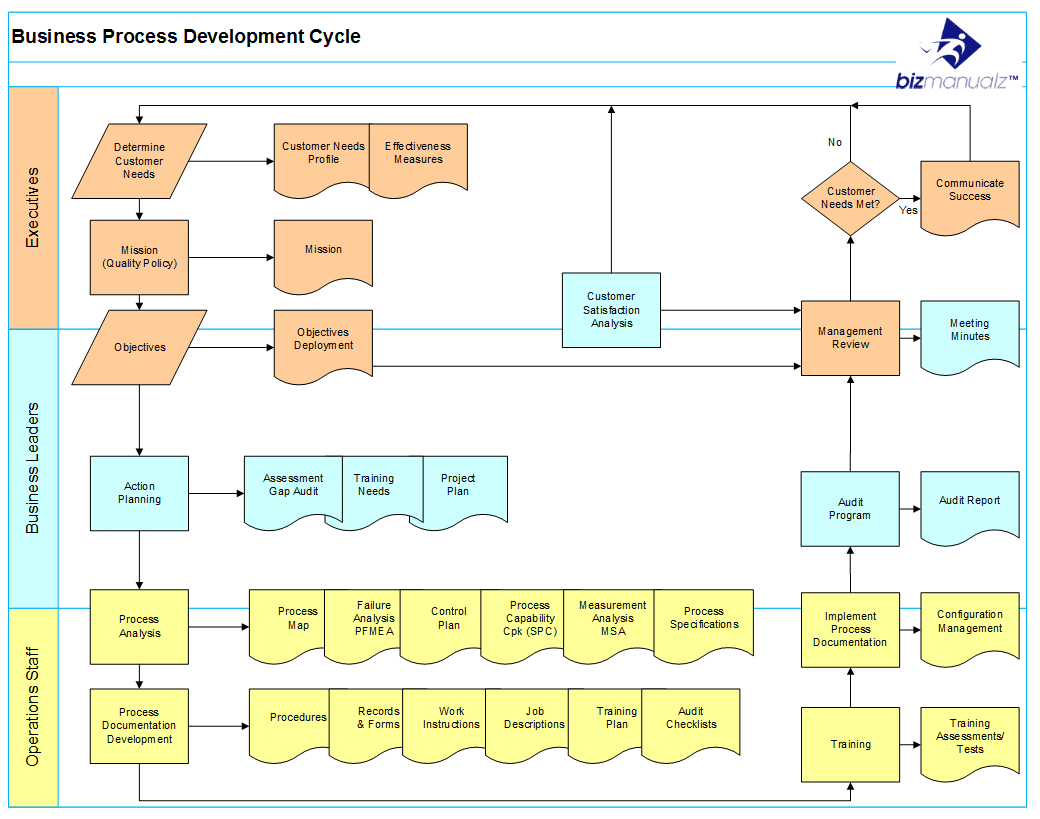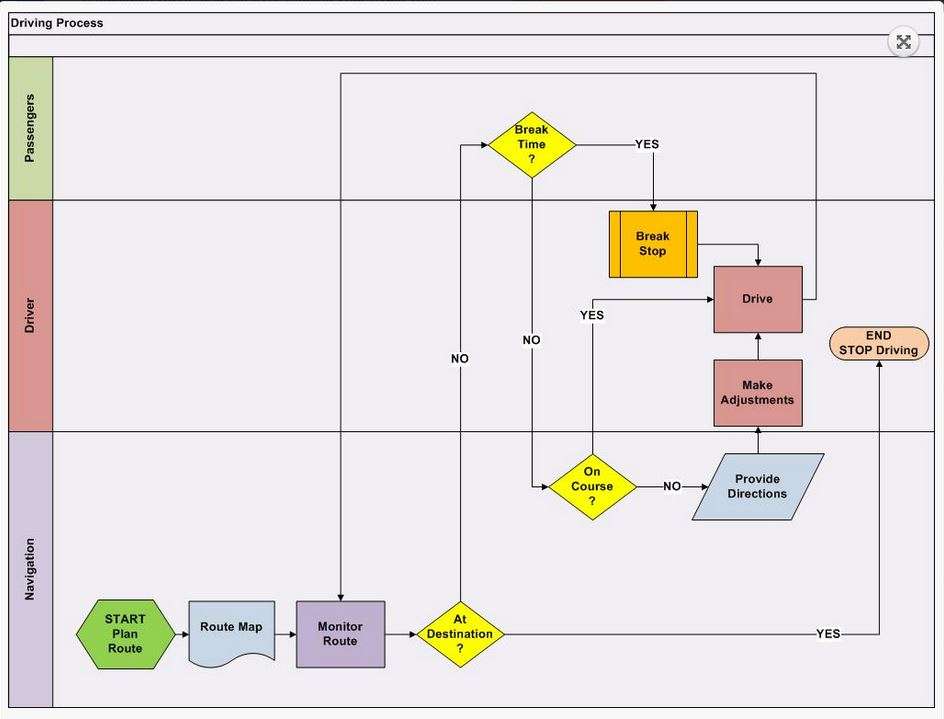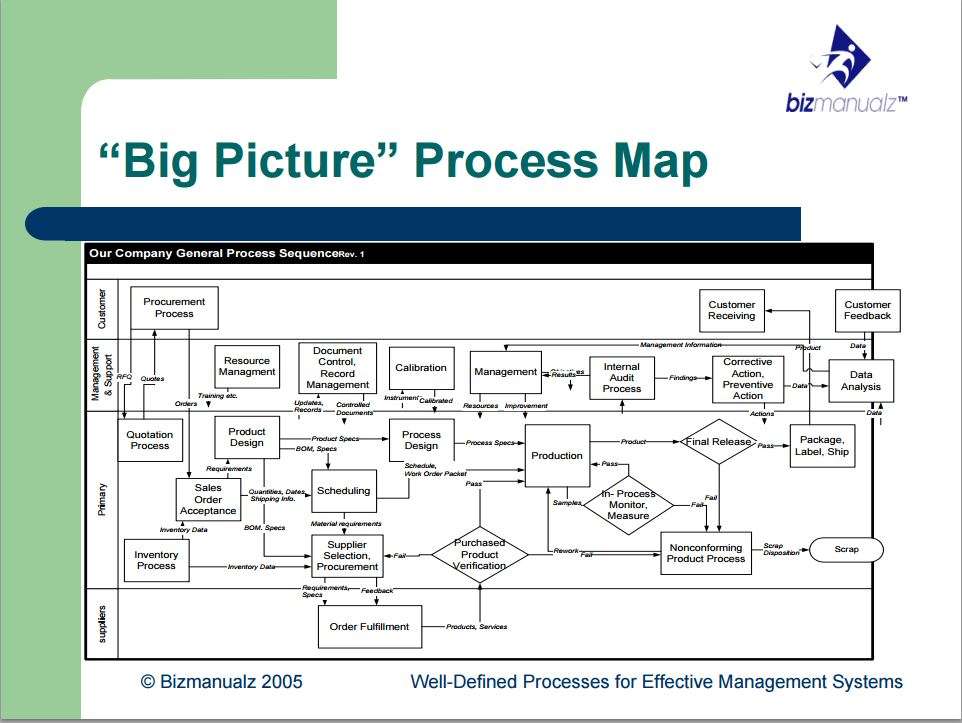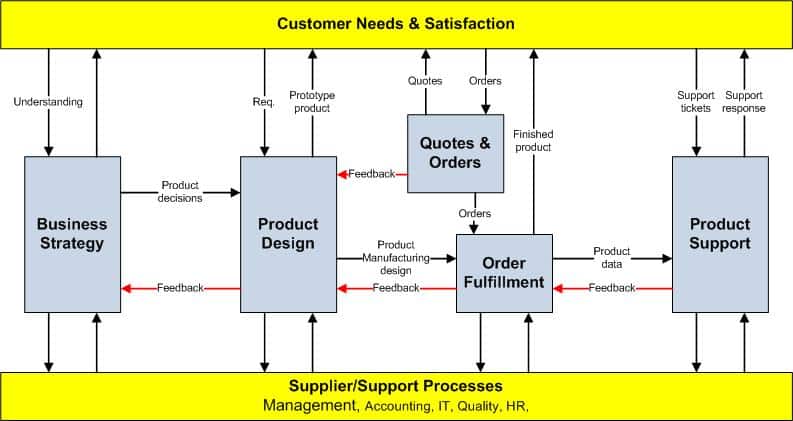What Is Meant by Business Process Mapping?

Business Process Mapping communicates your processes using workflow charts in order to achieve your business management objectives. What Is Meant by Business Process Mapping?
How are Process Maps Used?
Implementing strategy without process maps is like navigating a family road trip without a road map. It usually doesn’t work out.
The national map is a High-Level Process Map. It shows the major systems (states) and how communication (highways) pass through them. If you were updating your company’s automation supporting order-to-cash software, you might want to review a high-level picture showing how Purchasing moves a quote to Production, and Production sends finished goods to Shipping.
High-Level Process Map
A High-Level Process Map would show you right away that Shipping has to receive materials before shipping Finished Goods to customers. Knowledge of sequence and dependencies depicted in a High-Level Process Map helps you determine what happens first. Credit checks and accounts-receivables reviews happen before granting credit to customers, so you might want to work on the estimating and accounting software packages before redoing the invoicing systems.
 Low-Level Process Map
Low-Level Process Map
A Low-Level Process Map, like a Swim Lane process map, show the functions that must occur for a successful journey, like “Drive” and “Navigate”. Swim Lane Maps show responsibility for each activity and when various parties need to accept information from (or hand off to) one another.
One can come to appreciate that maps get all the information out in the open. And should things go in the wrong direction, you can point to the map. Interested parties can discuss the map calmly, with no need to comment on anyone’s innate abilities such as hearing or sense of direction.
Swim Lane Process Maps
At this point, you might see how Swim Lane Process Maps could come in handy in your company, when you consider how systems will support people who provide information and work-in-process to each other, and vice versa. For example, the sales department is supposed to hand off orders to the credit department which, in turn, performs the credit check based on management criteria.
The IT department should want to know about responsibilities, dependencies, and hand-offs — which a Swim Lane Map can convey easily and concisely — before they begin to plan, develop, debug, and roll out software.
Process Mapping Communicates Business Processes
A process is a structured set of activities that transforms inputs into outputs, but the way we describe a process may vary dramatically, from a text-based procedure to different forms of process maps.
Process Mapping
Process mapping is used to produce a clear understanding of a process or series of processes using a workflow diagram or flow chart. Business Process Mapping is used to produce a clearer understanding of business processes.
Process Mapping Purposes
Process maps are used for various purposes, including, but not limited to:
- Developing business process understanding;
- Business process improvement and discussion;
- Documenting a business process; and
- Training and communication.
Business Process Mapping Highlights Problems
A business process map highlights actual and potential problems –bottlenecks, backflows, delays, waste, and process gaps. Process maps clarify business process boundaries, ownership, responsibilities, and effectiveness measures (metrics). Process maps are used in mergers and acquisitions (M&A), business process improvement, and systems design.
Limits of Business Process Mapping
Business Process Mapping can’t do the work for you. A process map does help you establish a shared understanding of the scope of a business process and how it cuts across – links – business functions. The workers must still do the work.
However, business process maps can be used for designing processes, writing procedures, defining and achieving objectives, complying with quality standards like ISO 9001 (click link for free ISO 9001 2015 procedures), and building internal control.
All process maps are not created equal, however. The process mapping table below shows the purpose of each, as well as its positives and negatives:
|
Process Map Type |
Purpose |
Positives |
Negatives |
| High-Level Process Map or Flow Chart | Perspective, big-picture, Systems | Management, Quality Manual, good for adding metrics | Not enough details |
| Low-Level Process Map or Flow Chart | Sub-processes, small-picture | Understanding flow, procedures, details | Unclear responsibilities, Not SIPOC, alternative flow |
| Cross Functional or “Swim Lanes” Map | Responsibilities | HR, job descriptions, job training, procedures | Alternative flow |
| Document Map or SIPOC Map | Data management | Document and record control | Not enough activity detail |
| Activity Map or Value Stream Map | Process Improvement | granular details good for work instructions and procedure writing | OK for training and communications |
| Workflow Diagram | Training, communications | More realistic | Great for training and communications |
| Rendered Process Map | Training, communications | Most realistic | Great for training and communications |
Business Process Mapping is About Communicating
Most importantly, process mapping is about communicating your process to others, so you can achieve your business objectives. Business policies and procedures communicate your expectations using text. Business process mapping communicates your expectations using flow charts making a visual representation of your business process. People that are visual will find it much easier to understand a process map.

















GREAT AND SIMPLIFIED PROCESS MAPPING OF GENERAL EXAMPLE.
VERY USEFUL TO UNDERSTAND AND IMPLEMENT